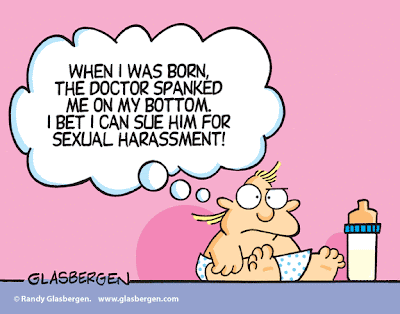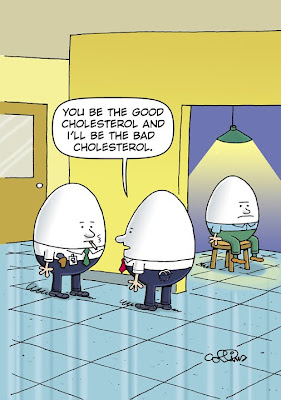
Randy Glasbergen is everywhere. Randy writes and draws
THE BETTER HALF, syndicated by King Features,
THIN LINES, syndicated by Creators Syndicate, and produces about a million gag cartoons for magazines, web sites, greeting cards, and T-shirts.
I believe Randy is not actual an human, but rather the very sophisticated robot known as CARTOONITRON-5000, created in the late 1960s by a cooperative of writers, artists, and the government.
Check out Randy’s work at his
website and prepare to be amazed!
1. When you were a kid, did you want to be a cartoonist? Did you draw?When I was a kid, I was always drawing. At first I copied characters from TV (Popeye, Hanna-Barbara and Jay Ward stuff) then I drew lots of Batman and Superman for a while. When I was around 14 (1971), I became more serious about becoming a cartoonist and started writing to my favorite cartoonists for advice and received many great replies. (Many years later, this was the inspiration for my book "How To Be A Successful Cartoonist") I tried gag cartooning around this time and started selling cartoons to many magazines when I was 15 years old, including
Saturday Evening Post,
Kipplinger's, Changing Times,
Sports Afield,
Good Housekeeping and
Saturday Review. I also had my first children's book (
Ickle McNoo) published around this time, copies of which can be found on eBay.
2. What was your first paying cartoon job?My first published cartoon appeared in the
New York State Conservationist magazine at age 14. My first paid cartoon was to
Cartoon Carnival magazine for $5. (Trash collector to smirking dog: "Stop calling me a junkie!")
 3. How did you get involved with the syndicated strip, THE BETTER HALF?
3. How did you get involved with the syndicated strip, THE BETTER HALF?In the late 1970's I had a contract with Rupert Murdoch's syndicate (Murdoch News Service) for a panel called HOWIE, which appeared in a number of papers at that time. That syndicate folded and was acquired by The Register & Tribune Syndicate, which was a major syndicate at that time with FAMILY CIRCUS, SPIDER-MAN and other successful strips.
In the early 1980s, when RTS was ready to hire a new cartoonist for THE BETTER HALF, they knew my work well from the HOWIE panel and hired me based on that. I was in my early 20's and had virtually no time to prepare and had to hit the ground running almost immediately.
The early cartoons were awful (in my opinion) but I've gradually evolved TBHalf into something that is uniquely my own, not an imitation of another cartoonist's art or gags.
King Features syndicates THE BETTER HALF now and it's recently begun appearing in a large number of online newspapers where it's often ranked as one of the most popular strips and panels.
4. You’re one of the industry’s most prolific gag cartoonists. What’s your secret?Ask any active freelancer like Harley Schwadron, Marty Bucella, Rex (Baloo) May or Mark (Andertoons) Anderson, and they'll probably tell you they draw 5-10 cartoons a day. It's not that uncommon. I average 6-8 cartoons a day, 5-6 days a week for a total of 30-45 cartoons per week, some for syndication, some for my website and freelance submissions.
Working at home, I have two flights of stairs for my commute and no coworkers to distract me or waste my time, so staying busy and keeping organized is fairly easy for me.
5. What’s your favorite rejected strip or gag?If I have a favorite cartoon, I'll publish it on my website.
6. Where do you stand in the print comics vs. web comics debate?Print or web makes no difference to me. I do both. My web comics eventually become print comics and my print comics usually spend some time on the web. I don't see any great wall between the two.
7. Newspaper comics are considered pretty tame compared to TV and other media. Do you find this limiting or is it a welcome challenge?This can be frustrating, especially when a word like "damn" would add some needed punch to a gagline. On the other hand, I purposely push the envelope a little bit with THE BETTER HALF with quite a bit of sexy banter between the two, physical affection, intimate talk...but without any of it being crude.
People who are unfamiliar with TBHalf assume it's a LOCKHORNS clone, but nothing could be further from the truth. The Lockhorns seem to despise each other, but THE BETTER HALF characters are as frisky as a couple can be trapped inside depressing middle-aged bodies.

On my website, I will be a bit more liberal with those cartoons, but I'm still careful not to offend anyone. My job is to entertain, not offend. Plus it's harder to sell a cartoon that offends and that is always a major consideration.
8. Name five of your favorite cartoonists.Several cartoonists influenced me when I was getting started, among them Sam Gross, Dik Browne, Virgil Partch, Roger Bollen, Bob Weber, Russell Myers Charlie Rodrigues. Most of all, I was influenced by New Yorker cartoonist Henry Martin, not so much by his art but I loved his gags. Anybody who doesn't know his work should check eBay or maybe the archives of The Cartoon Bank online.
9. Should the Lockhorns try open marriage to spice up their relationship?No comment.
10. How do you develop ideas? Which comes first, words or pictures?Sometimes I write at the computer, looking at other cartoons or doing some sort of research online to stimulate ideas. For example, if I'm working on dog cartoons I'll Google "dogs" and see what pops up to help me get some ideas. Other times, I'll sit down with a yellow legal pad and a copy of
Gag Recap and work until I get about 10 ideas (this usually takes 60-90 minutes). I usually write from 10:00 to 11:30 each morning, sometimes in my studio and other times out on our sunporch during good weather.
11. Do you ever worry about running out of ideas?How can you run out of ideas? There are 10 billion words in the dictionary and each word can be the basis for a new gag. Cartoons grow from magazine articles, newspaper articles, conversations, observations, the sources are endless.
Each night at dinner I ask my wife, "Did you bring home a good work story?" and that often inspires a gag or two.
When I was starting out, Johnny Hart advised me to "Think Funny" and that may be the best advice I ever got.
 12. What’s more important, raw talent or perseverance?
12. What’s more important, raw talent or perseverance?I don't know.
13. What kind of editor do you prefer, hands-on or laissez-faire?I don't know. I took Spanish in high school. Ask my wife, she took French.
14. What are your favorite books, TV shows, songs and films? (Yes, that counts as one question.)This question can probably be answered best by a quick visit to my Facebook or MySpace pages.
I like old Woody Allen movies, Marx Brothers, all of those movies with Christopher Guest, Michael McKean, Paker Posey, etc. I like Steve Martin's essays from
The New Yorker.
I mostly read biographies and nonfiction books. And I love listening to Tiffany Granath on Sirius radio every afternoon...she always cracks me up, like a female Howard Stern...it's an "adult" program, but it's okay because I'm an adult.
15. What are your tools of the trade?I work with very simple tools: heavy weight bond typing paper, Flair felt tip pens, a bottle of Liquid Paper and some Sharpies. After I draw my cartoons on a huge oak drawing table, I scan them into Photoshop on my Mac to colorize, digitize, etc. The computer has revolutionized both the art and business of cartooning. At least 95% of my sales come via computer now instead of the old method of putting cartoons in the mail for editors to review.
 16. What’s the best part about being a cartoonist?
16. What’s the best part about being a cartoonist?I like working in my pajamas half the day. I like having my dogs in the office with me. I enjoy the work and the business. I like interacting with new customers all day on the computer. I like the excitement of making a new sale or landing a cool project. I like the income potential of being a freelancer, not having the limitations of a salary. I like not having to deal with office politics or annoying coworkers. I like being able to watch TV while I draw. I like getting to the end of my work day wishing I had more time to get things done instead of staring at a clock in somebody's office aching for 5:00 to come so I can go home.
17. Have you met any of your cartoonist idols? Under what circumstances?One of the first cartoonists I met was a hero of mine. When I saw him get out of a crummy rusty old car, it shattered a lot of my illusions about the profession. Until then,
Cartoonist Profiles had convinced me that cartoonists were all rich guys who played golf all day in Connecticut. Some of my early heroes have called me up years later to ask me for advice -- that's the greatest feeling in the world.
18. What advice would you give aspiring cartoonists?My advice to aspiring cartoonists is the same advice they get from Nike: "Just Do It." You'll learn as you go, trial and error, practice makes perfect. You can't force it or will it, you just have to DO it. You have to take action, not just talk about it or daydream about it. Take some kind of
action every day that will bring you closer to your goals...do SOMETHING.
19. How important are awards?If I had some awards they would probably mean more to me than they do now.
20. What’s something that nobody knows about you?I buy all that "As Seen On TV" crap. As a joke, I ordered a whole bunch of that stuff to give my brother and his wife for Christmas, Sham Wow, Miracle Knives, Mighty Putty, The Clapper, The Ov Glove, and lots more, all of it carefully researched online.

During my research, I learned that most of that stuff actually works very well. Since then, I'm hooked. "Now what did you order?!?" is my wife's most frequently asked question. But this crap is really good crap. Honest! Have you ever tried cooking a frozen turkey in a New Wave Oven----perfect every time, juicy, moist and tender!
 The ever intrepid John Read has just released the latest issue of the ever excellent Stay Tooned, which features a nine-page interview with yours truly. (Can you spot me?)
The ever intrepid John Read has just released the latest issue of the ever excellent Stay Tooned, which features a nine-page interview with yours truly. (Can you spot me?)





 I received the usual rejections (with many hand-written notes of encouragement) until I got a phone call from Jay Kennedy at King. He wanted me to develop it further. After renaming the strip and modifying it to make it more universally appealing, I went through a second audition of sorts. After a few months, I got a wonderful call back from Jay saying he loved it and wanted to launch it. Talk about the stuff dreams are made of.
I received the usual rejections (with many hand-written notes of encouragement) until I got a phone call from Jay Kennedy at King. He wanted me to develop it further. After renaming the strip and modifying it to make it more universally appealing, I went through a second audition of sorts. After a few months, I got a wonderful call back from Jay saying he loved it and wanted to launch it. Talk about the stuff dreams are made of.



























